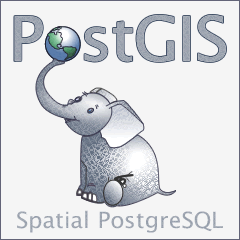Manual PostGIS 3.5.0dev
DEV (Fri 26 Jul 2024 05:15:22 PM UTC rev. 8080637 )
Abstract
PostGIS es una extension del sistema de base de datos relacional PostgreSQL que permite almacenar objetos SIG (Sistemas de Información Geografica) en la base de datos. PostGIS incluye soporte de indices de tipos basados en GiST R-Tree, y funciones de análisis y procesado de objetos SIG.


Este es el manual de la version 3.5.0dev
 This work is licensed under a Creative Commons Attribution-Share Alike 3.0 License. Feel free to use this material any way you like, but we ask that you attribute credit to the PostGIS Project and wherever possible, a link back to https://postgis.net.
This work is licensed under a Creative Commons Attribution-Share Alike 3.0 License. Feel free to use this material any way you like, but we ask that you attribute credit to the PostGIS Project and wherever possible, a link back to https://postgis.net.
Table of Contents
- 1. Introducción
- 2. Instalación de PostGIS
- 3. Administración de PostGIS
- 4. Data Management
- 5. Consulta Espacial
- 6. Consejos de rendimiento
-
7. Manual de Referencia PostGIS
- 7.1. Tipos Geometry/Geography/Box en PostgreSQL PostGIS
- 7.2. Funciones de Gestión
- 7.3. Contructores Geométricos
- 7.4. Métodos de Acceso a Geometrías
- 7.5. Editores de Geometría
- 7.6. Geometry Validation
- 7.7. Spatial Reference System Functions
- 7.8. Geometry Input
- 7.9. Geometry Output
- 7.10. Operadores
- 7.11. Spatial Relationships
- 7.12. Measurement Functions
- 7.13. Overlay Functions
- 7.14. Procesamiento de geometría
- 7.15. Coverages
- 7.16. Affine Transformations
- 7.17. Clustering Functions
- 7.18. Bounding Box Functions
- 7.19. Referencia Lineal
- 7.20. Trajectory Functions
- 7.21. Version Functions
- 7.22. Grand Unified Custom Variables (GUCs)
- 7.23. Troubleshooting Functions
- 8. SFCGAL Functions Reference
-
9. Topology
- 9.1. Tipos en Topology
- 9.2. Dominios de Topology
- 9.3. Topología y Gestión de TopoGeometría
- 9.4. Topology Statistics Management
- 9.5. Constructores de Topología
- 9.6. Editores de Topología
- 9.7. Accesores de Topología
- 9.8. Procesamiento de Topología
- 9.9. Constructores de Geometría Topográfica
- 9.10. Editores TopoGeometry
- 9.11. Descriptores de Geometría Topográfica
- 9.12. Salidas de Geometría Topográfica
- 9.13. Relaciones espaciales de topología
- 9.14. Importing and exporting Topologies
- 10. Gestión, Consulta y Aplicaciones de Datos Raster
-
11. Raster Reference
- 11.1. Raster Support Data types
- 11.2. Raster Management
- 11.3. Raster Constructors
- 11.4. Raster Accessors
- 11.5. Raster Band Accessors
- 11.6. Raster Pixel Accessors and Setters
- 11.7. Raster Editors
- 11.8. Raster Band Editors
- 11.9. Raster Band Statistics and Analytics
- 11.10. Raster Inputs
- 11.11. Raster Outputs
- 11.12. Raster Processing: Map Algebra
- 11.13. Built-in Map Algebra Callback Functions
- 11.14. Raster Processing: DEM (Elevation)
- 11.15. Raster Processing: Raster to Geometry
- 11.16. Raster Operators
- 11.17. Raster and Raster Band Spatial Relationships
- 11.18. Raster Tips
- 12. Extras de PostGIS
-
13. PostGIS Special Functions Index
- 13.1. PostGIS Aggregate Functions
- 13.2. PostGIS Window Functions
- 13.3. PostGIS SQL-MM Compliant Functions
- 13.4. PostGIS Geography Support Functions
- 13.5. PostGIS Raster Support Functions
- 13.6. PostGIS Geometry / Geography / Raster Dump Functions
- 13.7. PostGIS Box Functions
- 13.8. PostGIS Functions that support 3D
- 13.9. PostGIS Curved Geometry Support Functions
- 13.10. PostGIS Polyhedral Surface Support Functions
- 13.11. PostGIS Function Support Matrix
- 13.12. New, Enhanced or changed PostGIS Functions
- 14. Informar de problemas
- A. Apéndice